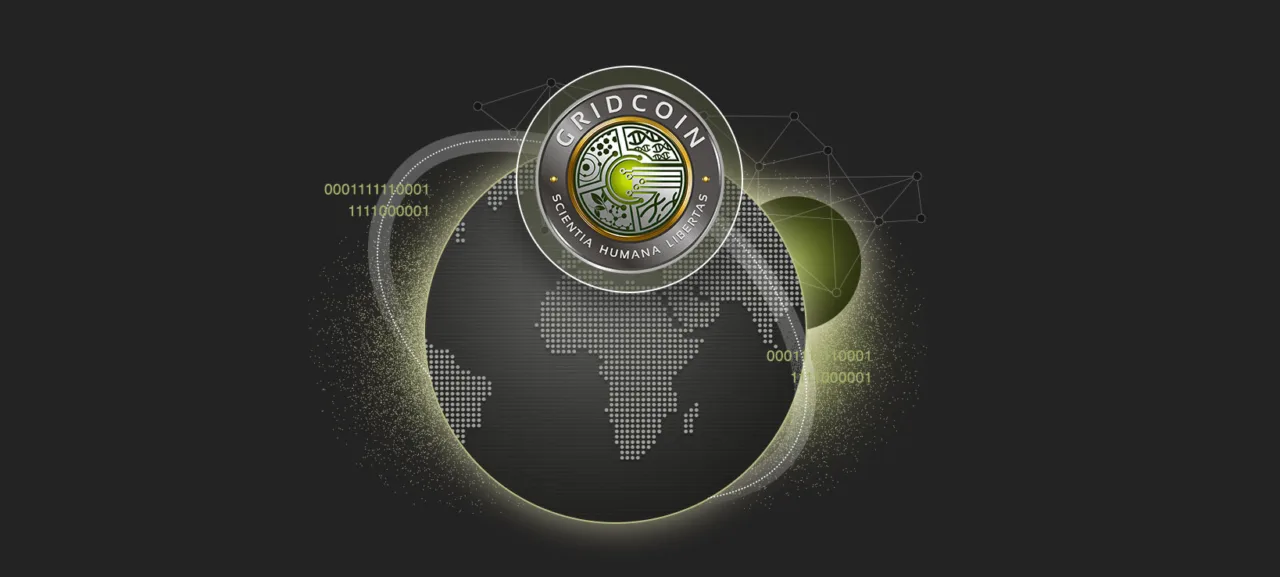What is BOINC
BOINC is an open platform for distributed computing. For more on what people compute with it today and how it works, see the article “Home Computing: How to Make Your PC Tackle Global Problems.” If you want to install BOINC yourself, don’t miss “BOINC, Ready for Battle: The Ins and Outs of Distributed Computing by Example.” By the way, you’ll also need BOINC for effective use of Gridcoin.
BOINC vs Bitcoin
Since 2002, the BOINC community has been volunteering to help solve scientific problems across a wide range of fields. Early on, the number of crunchers (volunteers) grew rapidly—it felt like it would never stop. Many ran workloads not just during idle time, but 24/7, pushing their machines to the limit. Noisy fans and an electric meter spinning like a fan didn’t faze them. Ordinary people were united by a big, altruistic idea—doing something good and lasting.
However, the idea alone wasn’t enough. Most people didn’t stick around because they weren’t getting any feedback. A month passes, then two… and where are the results?
At first, BOINC participants would share news about papers based on their pooled computations and rejoice that their computers were speeding up science. They helped study new proteins and promising materials, bringing new drugs and diagnostic markers closer to reality. New stars and new horizons opened up to them—it all felt like a fairy tale. Then came Bitcoin, then other cryptocurrencies, and the fairy tale turned into a nightmare.
As of today, the once multi‑million global army of BOINC crunchers has dwindled to just 300–400 thousand genuinely active accounts. Only about eight percent of all registered users are still actively processing BOINC tasks. The rest have turned into ghost accounts that consume more resources than they contribute.
The main reason for the mass exodus is straightforward: the most efficient workloads were GPU-optimized, and owners of high-end graphics cards rushed to hash in hopes of easy profit. We’re planning a separate article on how realistic that is and which cryptocurrency is the best choice. For now, let’s talk about a more niche option—Gridcoin.
Vice: The Engine of Progress
The name Gridcoin speaks for itself (grid — distributed network, coin — currency), but to me it’s more closely associated with the word greed. I think the creators of the open-source cryptocurrency Gridcoin were deliberately betting on that greed. They started paying for volunteer computing, which fundamentally changed how people viewed the process. Thanks to them, participation in distributed computing stopped being purely altruistic.
The idea behind Gridcoin was unveiled in October 2013, but it took a long time to turn it into a working product. The system is still far from perfect, yet it now runs reasonably stably. The cruncher community received the innovation ambivalently: some welcomed the initiative enthusiastically, while others were just as passionate in their criticism.
One way or another, people have been doing the computing for free for years. So why not get compensated for your effort now? Electricity bills won’t pay themselves, and Gridcoin (GRC) already trades for real money on exchanges. More precisely, you typically exchange GRC for BTC first, and then BTC for USD or EUR.
The beauty of Gridcoin is that it replaces wasteful mining with solving real-world problems. For example, it might process images from an automated observatory, predict a protein’s tertiary structure, or simulate heart function from ECG data. These practical workloads run in the background on ordinary computers without user interaction, and you earn virtual coins for contributing.
Join the Gridcoin team
Since Gridcoin runs on top of the BOINC platform, you need to become a cruncher first, and only then can you earn crypto rewards. When you join a new BOINC project and fill out your profile on its website, you can join an existing team or create your own. This is mostly symbolic, as you’re free to switch between teams without losing any of your accumulated credits—just like in football. Many crunchers leave the Team field blank. If you want to earn cryptocurrency for BOINC computations, set your Team to Gridcoin.

Step 0
We’ve already covered how to install BOINC and choose a project. Keep in mind that not all projects are community-vetted. You earn cryptocurrency only for contributing to scientific initiatives on the whitelist. Just make sure at least one of the projects you select is listed there.
Step 1
After setting up BOINC and joining the Gridcoin team, install the Gridcoin client application (see the links in the sidebar). It’s best to leave all paths and settings at their defaults, since custom configurations are more likely to cause errors.
In essence, the Gridcoin client is a blockchain-based cryptocurrency wallet. Because of that, it takes a while to download the blockchain on first launch and keeps it continuously synchronized. It uses several anti-tampering mechanisms, the main one being DPOR (Distributed Proof of Research)—proof of participation in research, in this case BOINC projects. Technically, it’s a combination of two methods: PoB (Proof of BOINC) and Proof-of-Stake (PoSv2)—proof of stake, i.e., holding coins in your account.
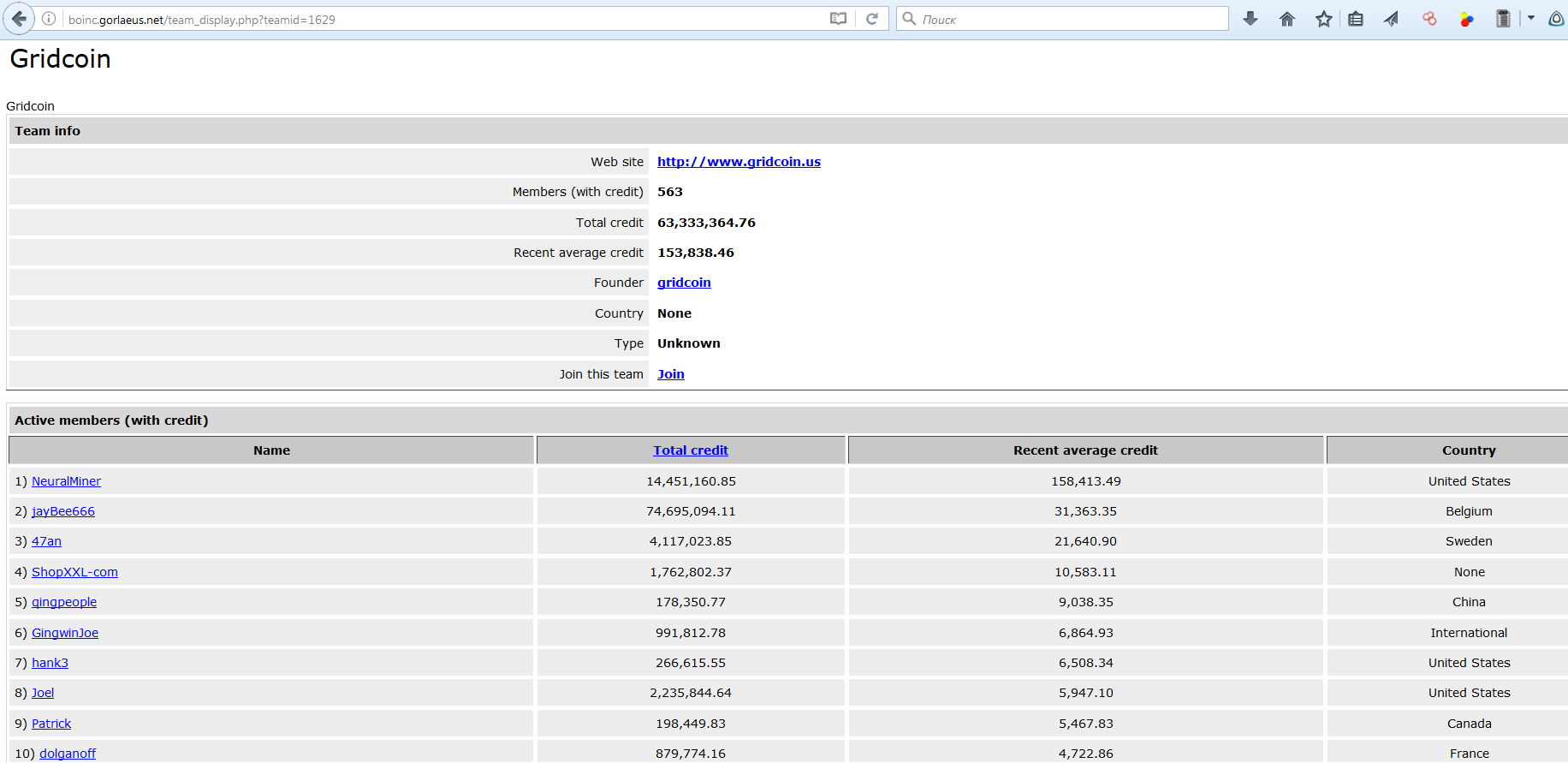
Instead of traditional mining, Gridcoin uses proof-of-work (PoW). To achieve this, the client software checks various conditions:
- Whether the BOINC client is installed
- Whether the BOINC process is running
- Whether the user’s Cross-Project Identifier (CPID) is registered in the distributed computing network
- Whether the participant is active (RAC > 0, i.e., Recent Average Credit)
There are other checks too, but let’s not get ahead of ourselves.
info
If you run into any issues, check the BOINC and Gridcoin forums. You’ll find answers to many questions in the FAQ.
Step 2
At this stage, you need to decide how you’ll participate: solo or as part of a crunching pool. There’s only one pool for now (there’s even a bounty for developing a new one), but it does offer a quick start. In a pool, you’ll receive rewards more frequently, but in smaller amounts.
Solo crunching takes significant upfront effort and plenty of patience, but it gives you maximum control. There’s also a third option for the truly lazy—Investor mode, essentially just processing other people’s transactions. You don’t need to run any scientific computations there; you earn small rewards for helping keep the Gridcoin network up to date. I’ll describe the following steps for the solo-crunching mode, since that’s what I chose.
Step 3
On Windows, the Gridcoin client requires administrator privileges. The developers recommend creating a shortcut to gridcoinresearch., opening its properties, and on the Compatibility tab selecting “Run this program as an administrator.”
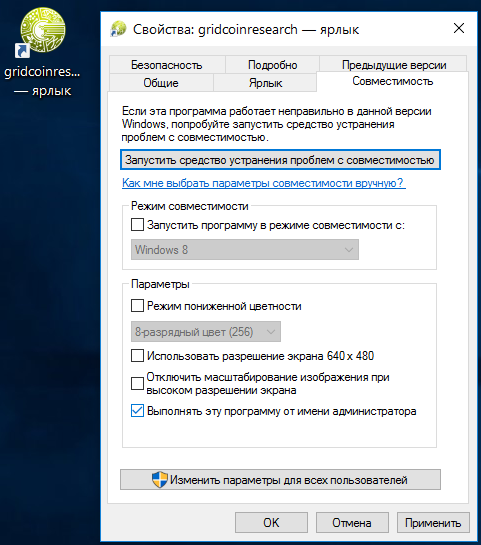
Yes, it’s theoretically unsafe; however, in six months of testing I haven’t seen any issues, and the app’s code is open source.
Step 4
Run the Gridcoin client on the same computer where BOINC is running. If your firewall prompts you, allow the app/create allow rules. If it doesn’t, add the rules manually (see the connection settings in the Gridcoin client under Options → Network).
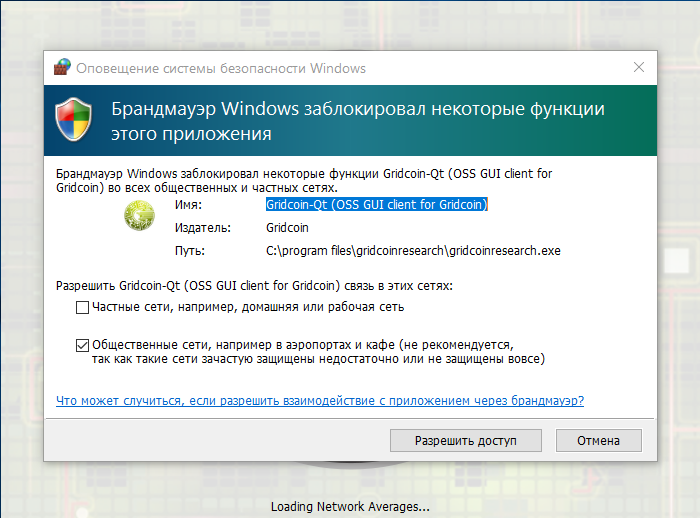
Step 5
Wait for the client to load (the first launch can take ages—long enough to go to work or get a decent sleep), and you’ll be taken to the new user setup wizard. There, enter the email address you used to register for BOINC projects.
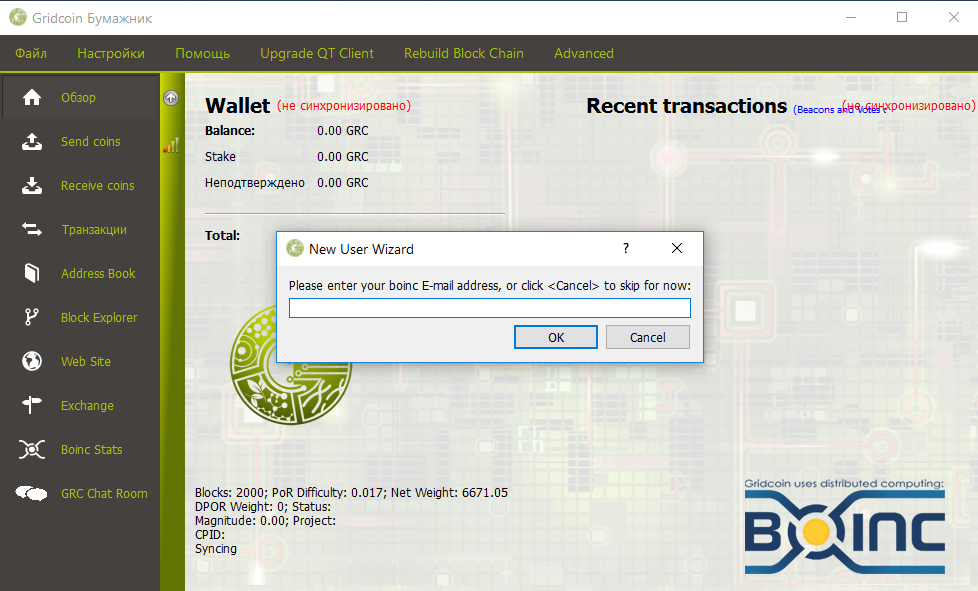
If you completed the previous steps correctly, you’ll see the message: “The new configuration file was created successfully.” We’ll come back to it shortly.
Once you’re online, the Gridcoin client will connect to the project and statistics servers and fetch all the data automatically. If the setup wizard didn’t start right away or you closed it by accident, you can always launch it manually. Note that you don’t need to enter any passwords—those fields are likely leftovers from an older version, and everything works without them now.
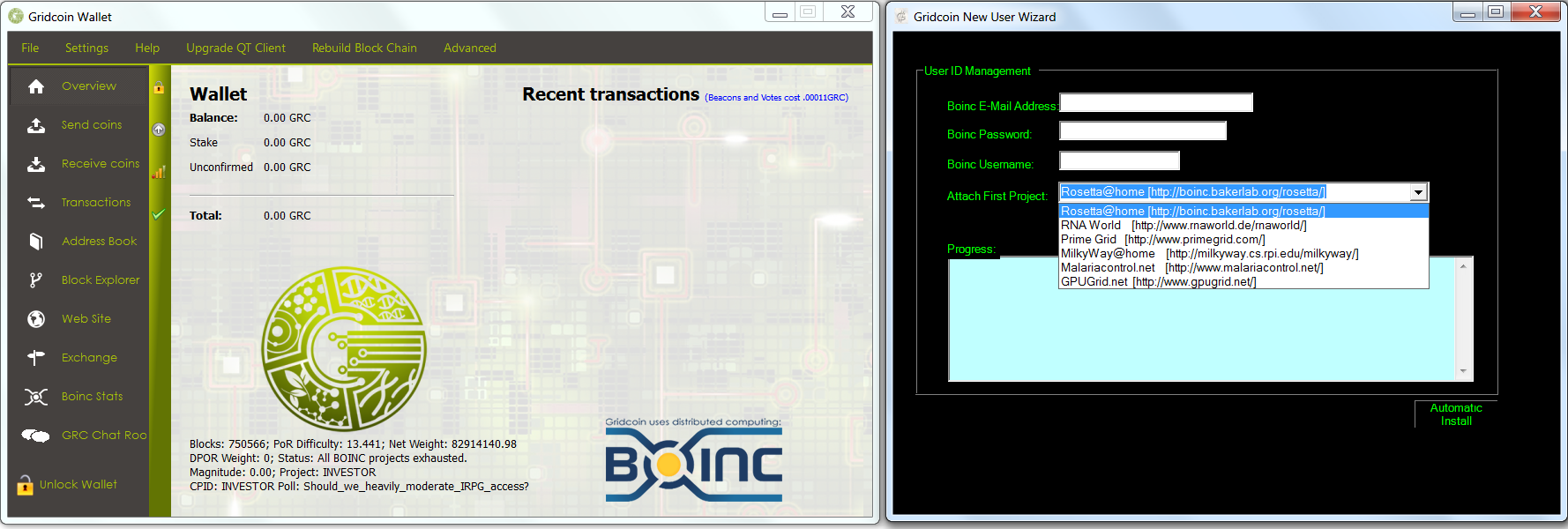
Step 6
Check the configuration file gridcoinresearch.. If you installed BOINC to a non-default path, specify the actual path in the config. On Windows, the relevant lines look like this:
boincdatadir=C:\\\\ProgramData\\\\BOINC
boincappdir=C:\\\\Program Files\\\\BOINC
On Linux:
boincdatadir=/var/lib/boinc-client/
If the path is set incorrectly, Gridcoin will throw an error on every startup.

Also check that your email address is entered correctly (the email= line). It’s used as your global user identifier.
Step 7
On the first launch (as Administrator!), the Gridcoin client should download the blockchain automatically. If the automatic synchronization doesn’t start or completes with an error, you can force it via Rebuild block chain → Rebuild block chain or Download Blocks.

Once the snapshot is loaded, synchronization will reach 99.99%. The client will automatically catch up to 100% by downloading the newest blocks shortly after.
Step 8
Moving to the next stage isn’t easy, so be patient. For quite a while you’ll see zeros in the main fields of the Gridcoin client, and the CPID line will show Investor instead of your cross‑project identifier—almost as if you weren’t doing any BOINC work at all. Don’t worry, that’s expected. New nodes take a long time to be incorporated into the Gridcoin network, and the payout window was recently extended from two weeks to six months. As a result, the wallet reflects not your current activity but your past contributions—recorded and confirmed by other participants over an extended period.
As soon as you receive your first coins (for example, from me—details in the sidebar below), broadcast your beacon to speed up getting your machine recognized by the Gridcoin network. To do this, open the Gridcoin client console and run: execute .
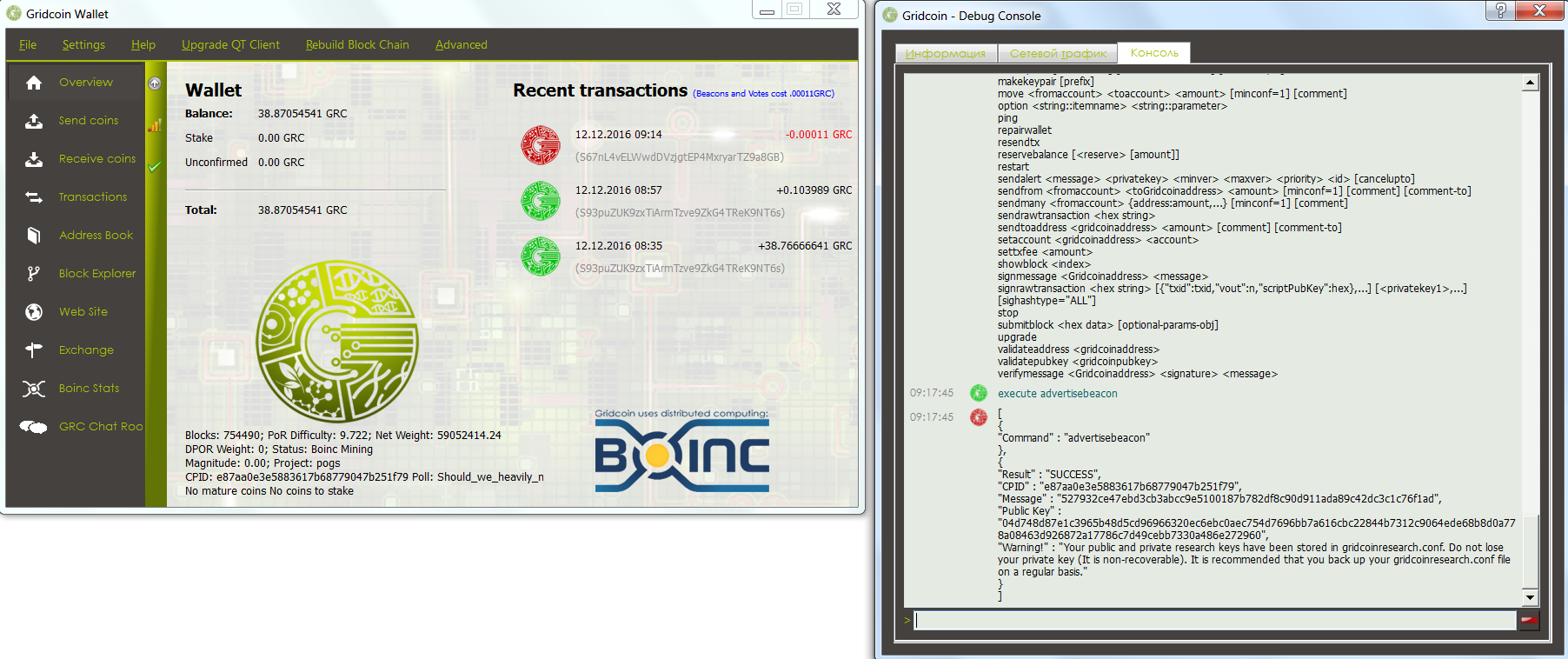
Rewards up for grabs
At first your PoS weight will be zero, putting you at the very end of the reward queue. Because of this quirk of the algorithm, the first payout can take a long time—anywhere from two weeks to a month and a half. During most or all of that period your status will show as Investor, even though you’ve chosen to crunch. That’s because you don’t become a full-fledged node in the Gridcoin network until you broadcast a beacon. Sending a beacon costs a tiny fee (fractions of a GRC), but you won’t even have that at the very beginning. There are a few ways to get through this initial phase faster and move on to the next stage (probing coin age):
- Visit a GRC faucet page and complete a simple task.
- Get some starter funds in the Gridcoin pool.
- Ask me to send you GRC in the comments under this article (don’t forget to include your wallet address).
Free sources of cryptocurrency are called faucets. Here’s one of the most popular for Gridcoin. It’s considered good form to send a few coins back once you’ve accumulated enough. Like similar services, it runs on donations.
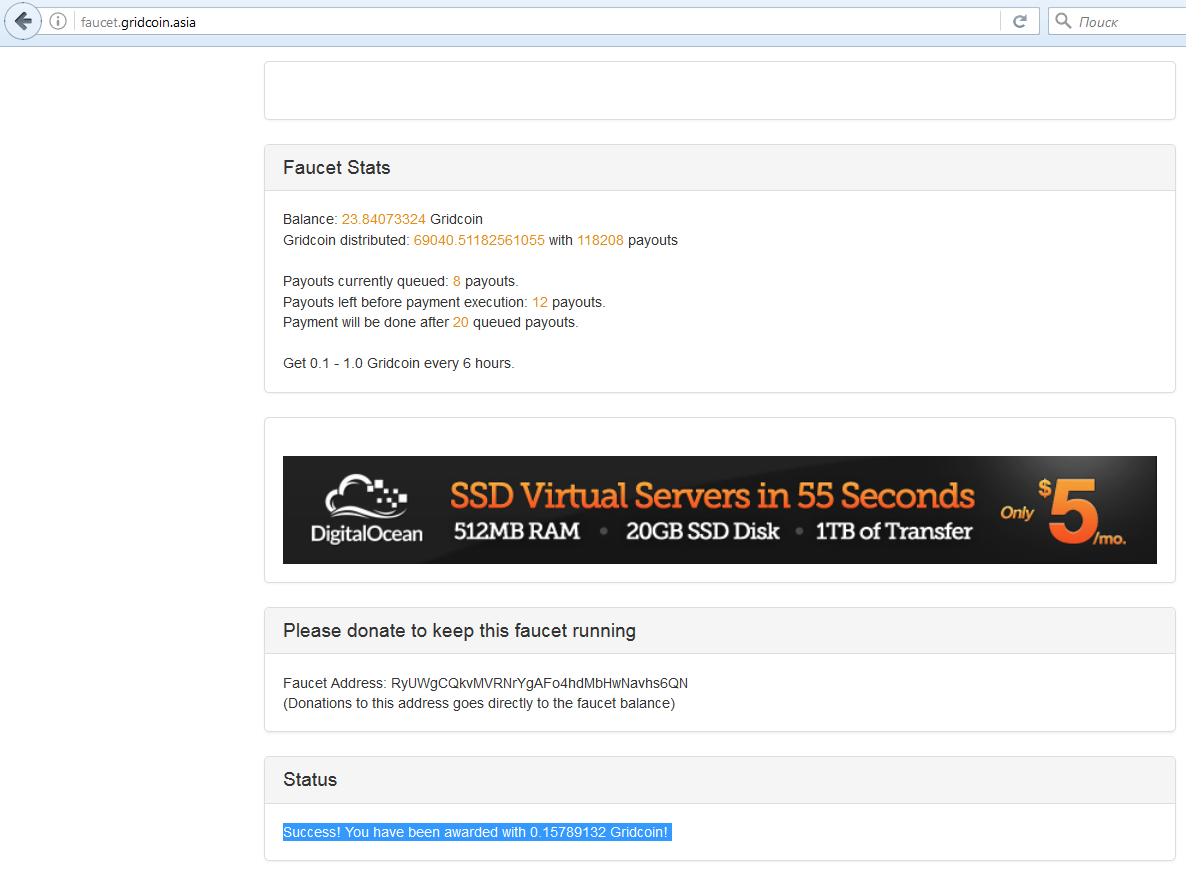
The Gridcoin pool also hands out starter coins whether you’re crunching in the pool or solo. The only requirement is that, at the time you request the starter grant, your RAC (Recent Average Credits) must be above 333.
If you joined BOINC long before installing the Gridcoin client, you won’t earn coins for work you’ve already completed. However, that past work will boost your RAC and other metrics, helping you get through the initial bootstrap period faster.
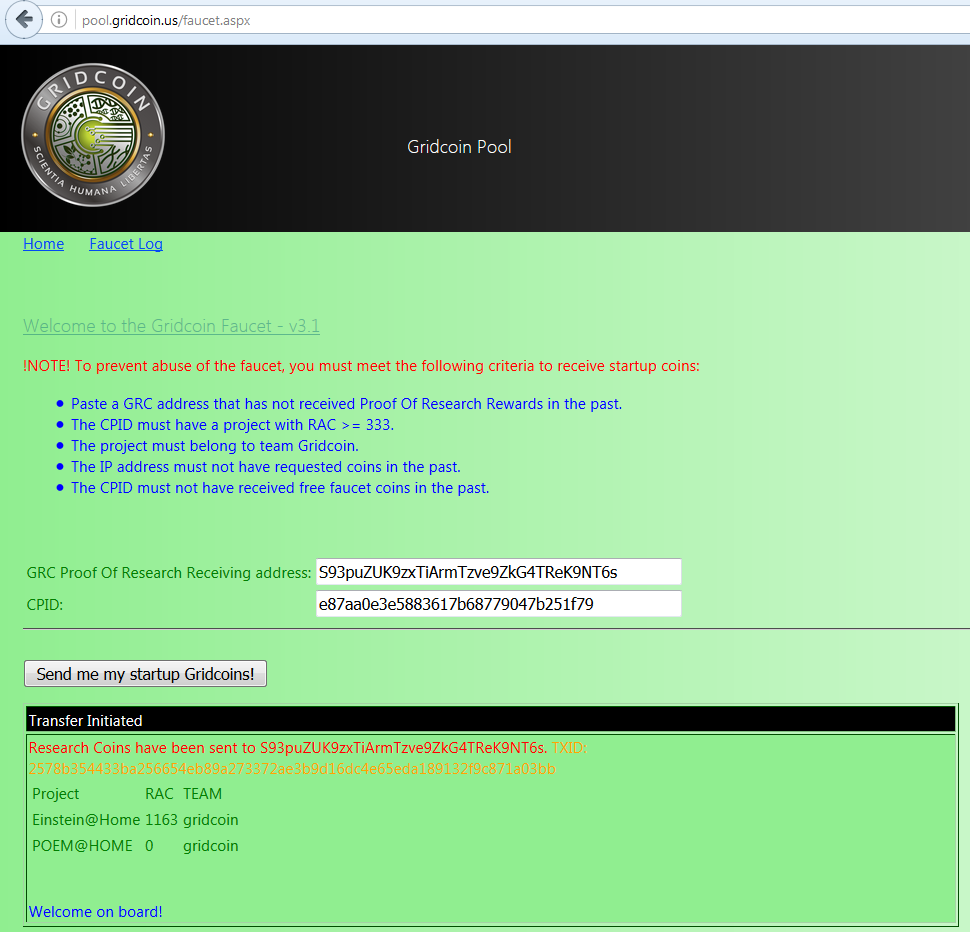
There are other ways to add funds to your account:
- Subscribe to Gridcoin news: http://uscore.net/
- Join the IRC chats: https://kiwiirc.com/client/irc.freenode.net:6667/#gridcoin
- Play games: https://kiwiirc.com/client/irc.freenode.net:6667/#gridcoin-games
- Swap another cryptocurrency for Gridcoin: https://poloniex.com/exchange#btc_grc
- Buy it directly from someone you know (I’m not selling :-))
If none of these options work for you (or you’re just feeling lazy), leave a comment here and I’ll try to send you some GRC. I can’t promise much, but even a small top-up can save you weeks of waiting and let you send your beacon sooner. You can find your wallet address in the Gridcoin client under Receive . You can generate multiple addresses and give different ones to different people. The first address is created automatically.
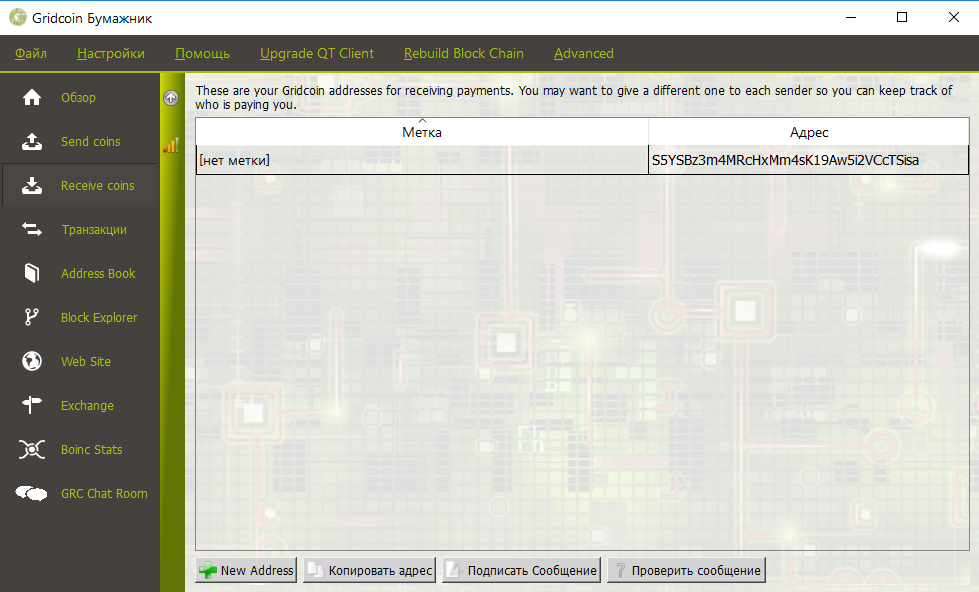
Once you’ve earned your first hundred coins, come back here. It’d be great if you could help other newcomers, too.
Step 9
If everything up to this step was done correctly, after sending the beacon you’ll receive Result: and a brief report. It will show your confirmed CPID, your public key, and a reminder that, along with the private key, it has been saved in gridcoinresearch.. This isn’t secure, so you should encrypt it (Settings → Encrypt wallet). From now on, every time you start Gridcoin it will ask for your password—don’t forget it!
Step 10
At the final step, enter the list command in the Gridcoin console. It will return a detailed report showing your verified CPID, which BOINC projects are being credited, and which ones still have a RAC that’s too low. With that, the core setup is complete, and your wallet will start receiving coins.

Console Games
The Gridcoin client interface is generally intuitive, but it does have a few non-obvious elements. For example, the green arrow in the top-left corner of the window isn’t just an activity indicator. Hovering over it brings up a tooltip that explains your account’s current status.
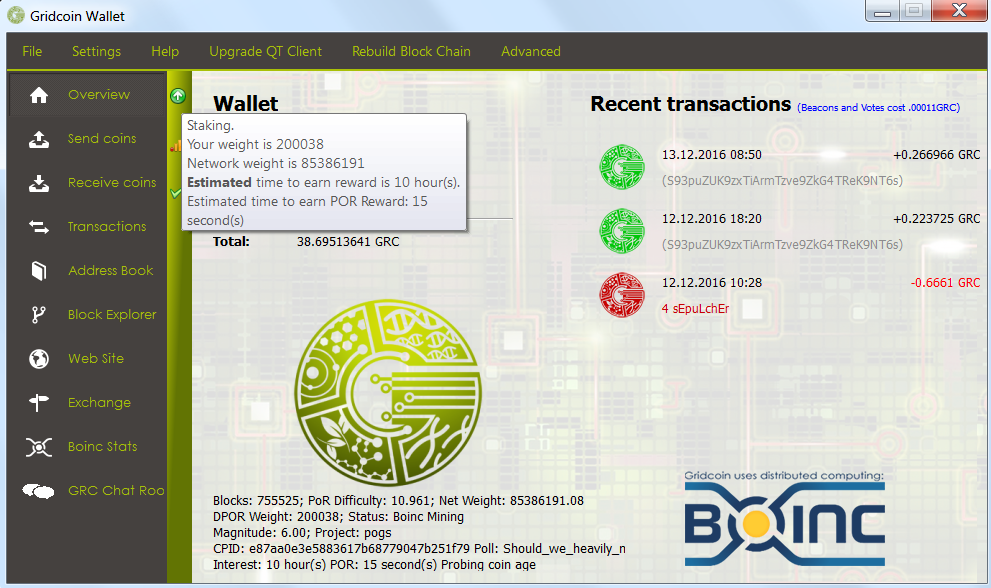
It even predicts the time of the next payout, though it rarely matches reality. The Wi‑Fi‑like icon below behaves similarly—it shows the Gridcoin client’s network activity and various details. But that’s all minor stuff. The real magic is in the debug menu. Open the console (Help → Debug Window → Console) and type help to get extensive documentation on the available commands.
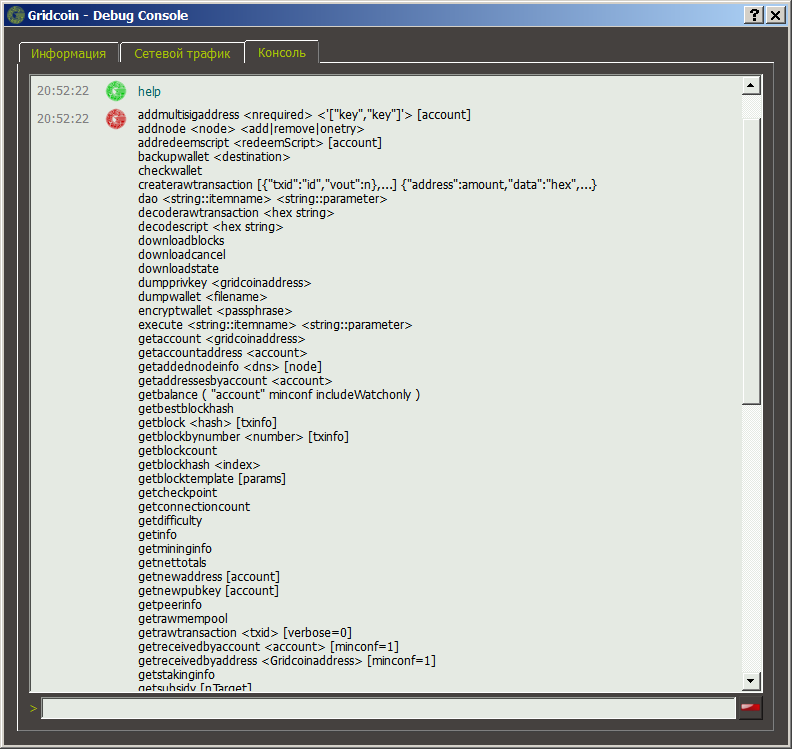
What Sets Gridcoin Apart
Gridcoin isn’t the only attempt to incentivize volunteers. There are also CureCoin (CURE), FoldingCoin (FLDC), and others. However, CureCoin’s price slid quickly and has never really taken off, while FoldingCoin’s chart looks more promising, but the system itself isn’t compatible with BOINC. It’s the native currency of another, older network—Folding@home.
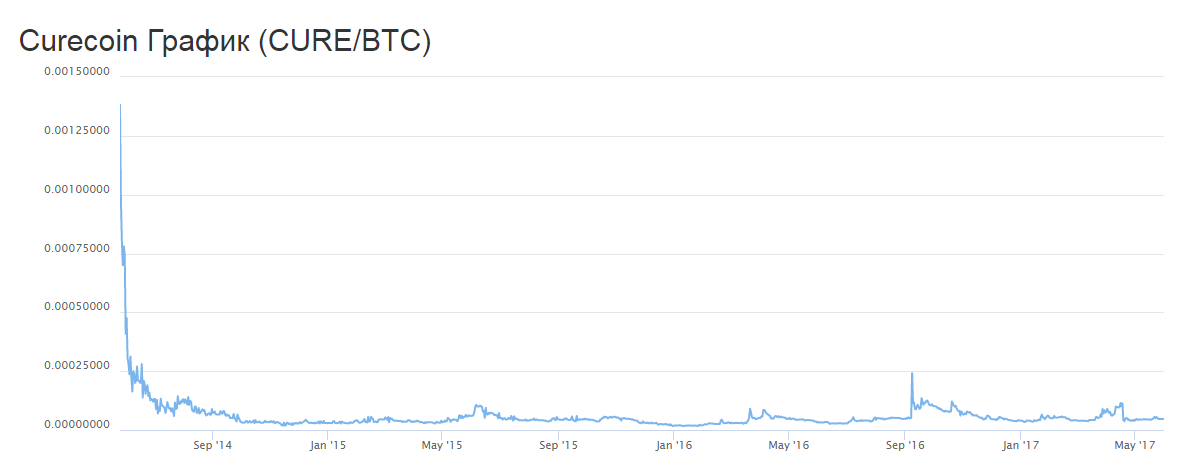
All Gridcoin rewards are mined using the scrypt algorithm, but there’s an important twist: the block reward is variable. If you simply install the Gridcoin client and keep it running, you’ll get 5 GRC for each new block. If, in addition, you participate in BOINC projects, you’ll earn between 6 and 150 GRC per block. That’s a pretty strong incentive.
In the second case, rewards aren’t paid for mining per se, but in proportion to the effort spent on scientific computations. BOINC tracks this efficiently and compiles all the necessary work statistics. The primary—though not the only—metric is the amount of computation. Depending on the project, a single task can involve anything from billions to quadrillions of floating-point operations, at varying precision. In addition to sheer volume, the time to complete a task and your relative contribution among all project participants are factored in. It’s one thing to be in the mainstream alongside hundreds of thousands of crunchers; it’s another to devote your resources to a niche project with only a couple of other people contributing.
These nuances are captured by a work-difficulty equivalent called the Cobblestone, or simply credit points. Originally, one Cobblestone represented the amount of computation a processor running at 1 GFLOPS could perform in 1/200 of a day—i.e., 432 billion single‑precision (FP32) operations. The scoring model was later refined: some crunchers contribute sporadically, others continuously. So, in addition to raw computation, contribution is now weighted by its regularity, measured as RAC (Recent Average Credit).
Crunchers often take part in several projects at once, allocating a bit of their resources to each. At the same time, turnaround time is critical for researchers—no one needs last year’s results. That’s why some projects award bonus points for fast completion. For example, on GPUGrid you’ll get an extra 50% credit if you return a task within 24 hours of receiving it, and 25% if you finish within 24–48 hours.
FYI: Gigaflops (GFLOPS)
A total of one billion floating‑point operations equals one gigaflop. Don’t confuse that with gigaflops, which measures compute speed. The total number of operations is written as GFLOPs, while the per‑second rate is written as GFLOP/s.
A few caveats
After you broadcast your beacon, your computer is added to the Gridcoin Neural Network. This happens when a superblock is created (once every 24 hours). So your status will switch from INVESTOR to BOINC after at least a day.
You can verify that the Gridcoin client is functioning correctly via Advanced → Diagnostics → Run Diagnostics. The script runs ten tests and displays their results.

Gridcoin has an open voting system. Topics up for vote include things like “Should we whitelist Project A?” or “Should we change the DPOR (Distributed Proof of Research) mechanism?” Voting isn’t free: there’s a small fee per vote, which helps ensure that the people casting votes are active Gridcoin participants.
All Gridcoin payouts are shown in the client window. The full log is on the Transactions page, and the three most recent operations appear on the right with different icons. The primary ones are labeled Mining PoR and are credited for BOINC computation. Smaller entries include transfers from “faucets,” other users, and PoS bonuses.
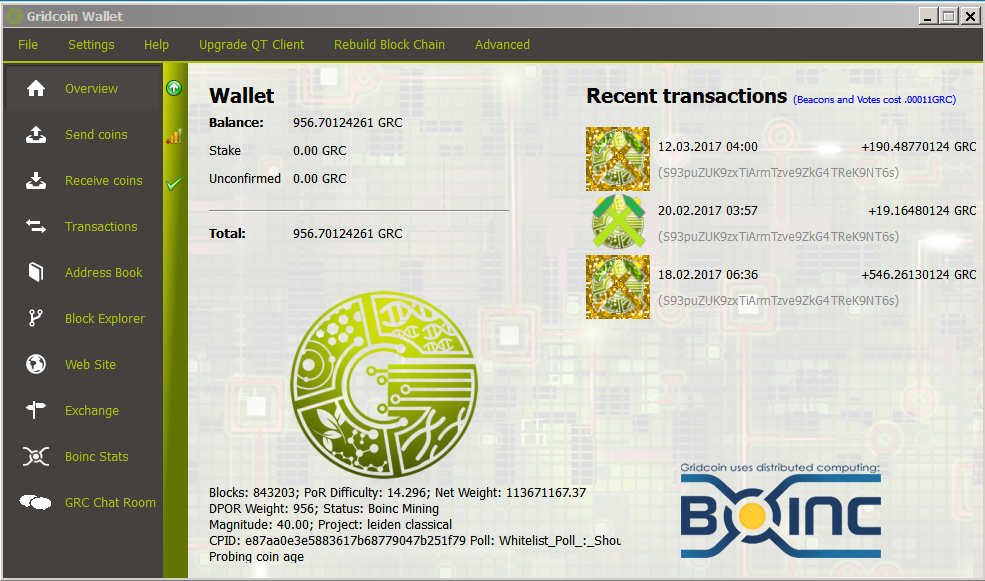
To send coins, just click Send coins, enter the recipient’s wallet address and the amount you want to transfer. You can also add a message to the recipient and set a fee if you want to speed up processing. All small transfers must include a fee to avoid overloading the Gridcoin network with trivial transactions. Don’t worry—the minimum is purely nominal, around 0.0001 GRC, or a bit more if you decide to raise it.
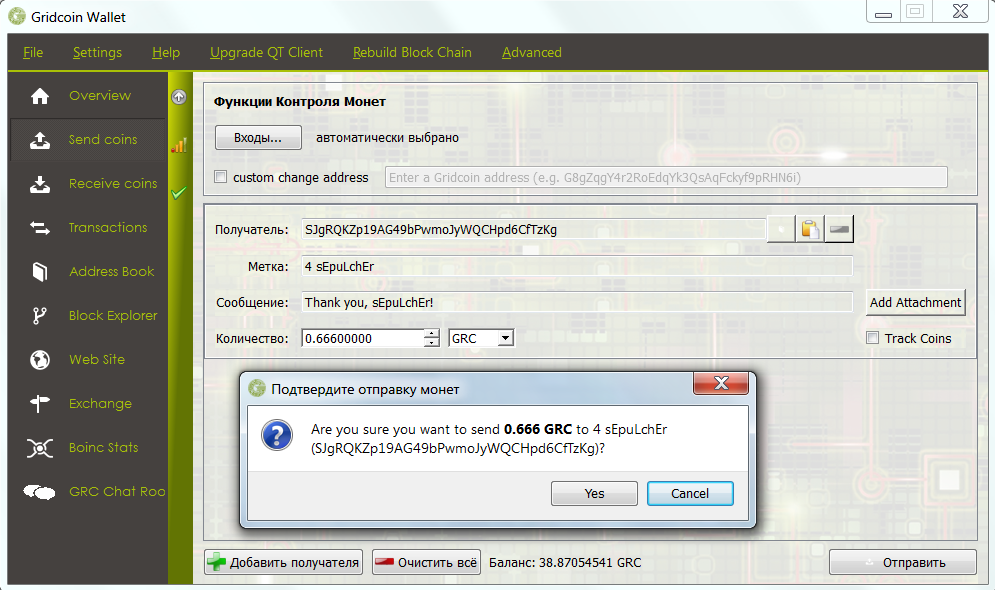
What matters isn’t your absolute weight (points or RAC), but your relative share. You can estimate it with this calculator. Just enter your CPID to see a table of BOINC projects and your relative weight in them compared to the Gridcoin team. The calculator is far from perfect and shows historical, validated stats rather than the current state, so don’t be surprised if a project you recently joined doesn’t appear in its table.
You might rack up a million points a day on a high-end GPU, but if the project is popular, don’t expect big payouts. The coins earned are split among all participants, which could be thousands of people. Conversely, a project that gives few points doesn’t necessarily pay out few coins. The key is whether it’s on the “whitelist.” Say that in some Vasya@Home project, only you and Vasya are still active. Then the two of you split the entire pot.
The relationship between compute volume, RAC, and payouts isn’t straightforward because of the long payout window (currently 182 days) and the fluctuating total Gridcoin network power. Even if you ramp up your computing, you won’t necessarily earn more coins. First, that additional credit is recognized only after a long delay. Second, the network’s total power may also have grown during that period, reducing your relative share.
All Gridcoin rewards are tied to your BOINC Cross-Project Identifier (CPID). You can crunch on multiple machines while running the Gridcoin client on just one. According to the official docs, the key is to use the same CPID on all your hosts. In practice, though, the current PoB validation can sometimes make the Gridcoin client count only those projects that exist in the local BOINC instance. So be sure to add all your selected projects on the machine where you’ll run the Gridcoin client.
The Gridcoin client for Windows relies on the .NET Framework. Make sure you have the latest version of the framework and all updates installed.
Most Gridcoin errors are caused by desynchronization due to incorrect system time on the local computer. Make sure automatic time synchronization is enabled and the time zone is set correctly.
The developer’s site recommends running the Gridcoin client 24/7 with admin privileges, but that’s not actually required. Even if you start it only occasionally and for just a couple of hours, you’ll still receive all the coins you’ve earned (as long as BOINC is running). The wallet just takes a long time to start up, even longer to sync, and the Gridcoin network benefits from having more active nodes. That’s why they make that recommendation.
Don’t be greedy—be patient! Distributed computing is a marathon, not a sprint. Whenever you can, support newcomers and join projects to advance science, not to chase cryptocurrency. That’s just a nice bonus, not a source of income.
